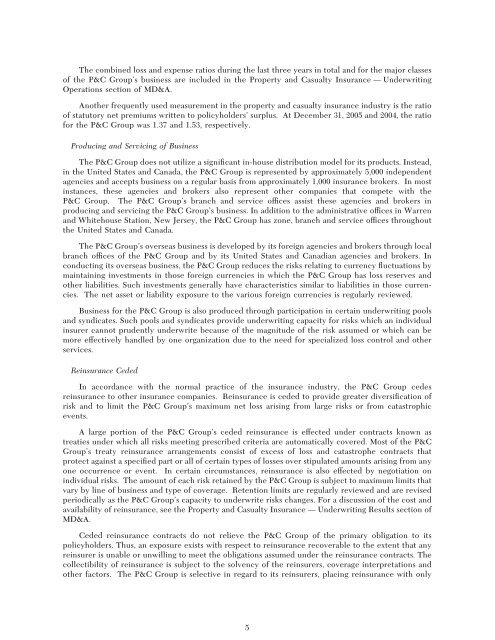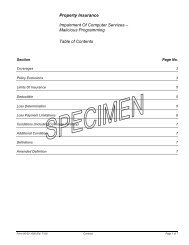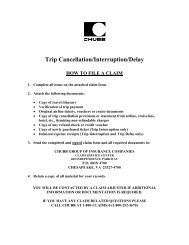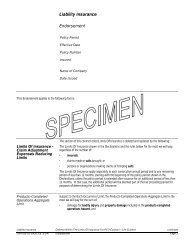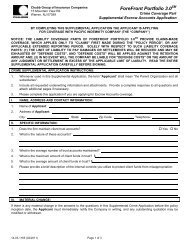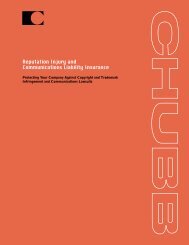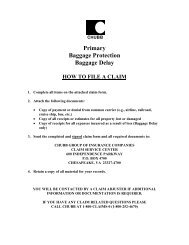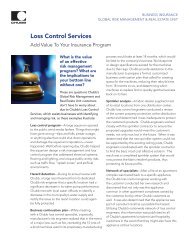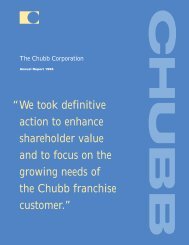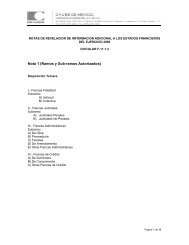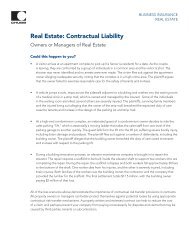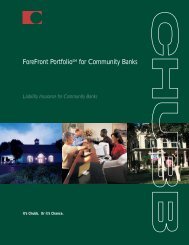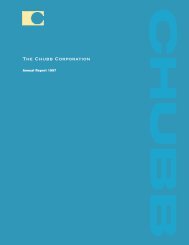Annual Report 2005 - Chubb Group of Insurance Companies
Annual Report 2005 - Chubb Group of Insurance Companies
Annual Report 2005 - Chubb Group of Insurance Companies
You also want an ePaper? Increase the reach of your titles
YUMPU automatically turns print PDFs into web optimized ePapers that Google loves.
The combined loss and expense ratios during the last three years in total and for the major classes<br />
<strong>of</strong> the P&C <strong>Group</strong>'s business are included in the Property and Casualty <strong>Insurance</strong> ÌUnderwriting<br />
Operations section <strong>of</strong> MD&A.<br />
Another frequently used measurement in the property and casualty insurance industry is the ratio<br />
<strong>of</strong> statutory net premiums written to policyholders' surplus. At December 31, <strong>2005</strong> and 2004, the ratio<br />
for the P&C <strong>Group</strong> was 1.37 and 1.53, respectively.<br />
Producing and Servicing <strong>of</strong> Business<br />
The P&C <strong>Group</strong> does not utilize a signiÑcant in-house distribution model for its products. Instead,<br />
in the United States and Canada, the P&C <strong>Group</strong> is represented by approximately 5,000 independent<br />
agencies and accepts business on a regular basis from approximately 1,000 insurance brokers. In most<br />
instances, these agencies and brokers also represent other companies that compete with the<br />
P&C <strong>Group</strong>. The P&C <strong>Group</strong>'s branch and service oÇces assist these agencies and brokers in<br />
producing and servicing the P&C <strong>Group</strong>'s business. In addition to the administrative oÇces in Warren<br />
and Whitehouse Station, New Jersey, the P&C <strong>Group</strong> has zone, branch and service oÇces throughout<br />
the United States and Canada.<br />
The P&C <strong>Group</strong>'s overseas business is developed by its foreign agencies and brokers through local<br />
branch oÇces <strong>of</strong> the P&C <strong>Group</strong> and by its United States and Canadian agencies and brokers. In<br />
conducting its overseas business, the P&C <strong>Group</strong> reduces the risks relating to currency Öuctuations by<br />
maintaining investments in those foreign currencies in which the P&C <strong>Group</strong> has loss reserves and<br />
other liabilities. Such investments generally have characteristics similar to liabilities in those currencies.<br />
The net asset or liability exposure to the various foreign currencies is regularly reviewed.<br />
Business for the P&C <strong>Group</strong> is also produced through participation in certain underwriting pools<br />
and syndicates. Such pools and syndicates provide underwriting capacity for risks which an individual<br />
insurer cannot prudently underwrite because <strong>of</strong> the magnitude <strong>of</strong> the risk assumed or which can be<br />
more eÅectively handled by one organization due to the need for specialized loss control and other<br />
services.<br />
Reinsurance Ceded<br />
In accordance with the normal practice <strong>of</strong> the insurance industry, the P&C <strong>Group</strong> cedes<br />
reinsurance to other insurance companies. Reinsurance is ceded to provide greater diversiÑcation <strong>of</strong><br />
risk and to limit the P&C <strong>Group</strong>'s maximum net loss arising from large risks or from catastrophic<br />
events.<br />
A large portion <strong>of</strong> the P&C <strong>Group</strong>'s ceded reinsurance is eÅected under contracts known as<br />
treaties under which all risks meeting prescribed criteria are automatically covered. Most <strong>of</strong> the P&C<br />
<strong>Group</strong>'s treaty reinsurance arrangements consist <strong>of</strong> excess <strong>of</strong> loss and catastrophe contracts that<br />
protect against a speciÑed part or all <strong>of</strong> certain types <strong>of</strong> losses over stipulated amounts arising from any<br />
one occurrence or event. In certain circumstances, reinsurance is also eÅected by negotiation on<br />
individual risks. The amount <strong>of</strong> each risk retained by the P&C <strong>Group</strong> is subject to maximum limits that<br />
vary by line <strong>of</strong> business and type <strong>of</strong> coverage. Retention limits are regularly reviewed and are revised<br />
periodically as the P&C <strong>Group</strong>'s capacity to underwrite risks changes. For a discussion <strong>of</strong> the cost and<br />
availability <strong>of</strong> reinsurance, see the Property and Casualty <strong>Insurance</strong> ÌUnderwriting Results section <strong>of</strong><br />
MD&A.<br />
Ceded reinsurance contracts do not relieve the P&C <strong>Group</strong> <strong>of</strong> the primary obligation to its<br />
policyholders. Thus, an exposure exists with respect to reinsurance recoverable to the extent that any<br />
reinsurer is unable or unwilling to meet the obligations assumed under the reinsurance contracts. The<br />
collectibility <strong>of</strong> reinsurance is subject to the solvency <strong>of</strong> the reinsurers, coverage interpretations and<br />
other factors. The P&C <strong>Group</strong> is selective in regard to its reinsurers, placing reinsurance with only<br />
5


